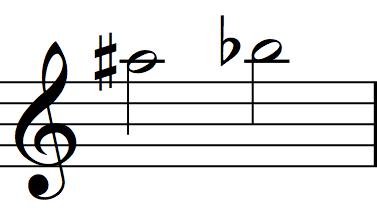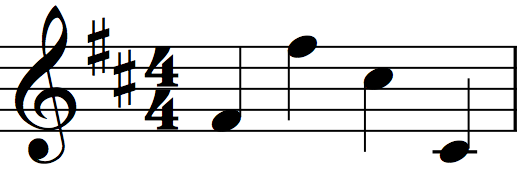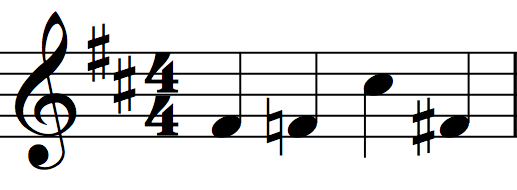16 More Notes, Key Signatures & Cut Time Meter
INTRODUCTION
In this unit you will learn more fretted notes on the first string, key signatures and cut time meter.
NOTATIONS
Notes
The Notes ‘A♯’ and ‘B♭’
‘A♯’ and ‘B♭’ are enharmonics. To play ‘A♯’ or ‘B♭’, fret the sixth fret on the first string.
The Note ‘B’
‘B’ sits on top of the first leger line above the staff. To play ‘B’, fret the seventh fret on the first string.
The Note ‘C’
‘C’ is in the second leger line above the staff. To play ‘C’, fret the eighth fret on the first string.
Key Signatures
Key signatures serve two important functions. First, they free the score of too much visual information, which in turn aids sight-reading. Second, they designate the key of the piece. A theoretical understanding of keys is useful, but not necessary for sight-reading. As long as you understand the rules outlined below you will be able to play music with key signatures. However, if you want to learn more about music theory, I advise you to enroll in a music theory course, or teach yourself via MusicTheory.net.
Rules for Key Signatures
The key signature is situated directly to the right of the treble clef. It usually contains a set of one or more sharps or flats. The key signature establishes the following rules:
- Each accidental in a key signature alters notes of that name (at all pitch registers of corresponding staff positions) throughout the piece, or section of a piece.
- If an altered note needs to be temporarily ‘undone,’ then a natural symbol will precede the note in the score to indicate the change. The change caused by the natural will only last for the duration of the measure.
Rule 1
The key signature above contains two sharps. The center points of the sharps are positioned where ‘F’ and ‘C’ are placed on the staff. This means that all ‘F’s and ‘C’s, in all pitch registers, are to be played sharp, even though sharp signs will not precede the notes in the score. In the example above, the notes to be played are F♯, F♯, C♯ & C♯.
Rule 2
The key signature above demands that all ‘F’s and ‘C’s are to be played sharp, unless ‘undone’ by a natural symbol. Notice the natural on beat two. The notes you must play in the example are: F♯, F-natural, C♯ & F♯.
More Key Signatures
Take a moment to familiarize yourself with the key signatures below that contain accidentals. Please note that key signatures usually contain either all sharps or all flats. However, a key signature can exists without sharps or flats as well. Two of the most common key signatures are entirely free of accidentals.
Key Signatures with Sharps
Key Signatures with Flats
Cut Time Meter
Cut time is a fairly common meter. It typically appears in the time signature as a ‘C’ pierced by a vertical line.
Cut time can also be represented by a 2/2 time signature (or with the phrase alla breve ).
Cut Time vs. Common Time
The rhythmic notation in cut time can look like the rhythmic notation in common time (AKA simple quadruple meter). However, the main difference between them has to do with rhythmic emphasis.
In the example above, notice how the beat accent falls on every half note in cut time and on every quarter note in common time. Think of cut time as having 50% fewer pulses than common time. This significantly alters the difference in feel between cut time and common time. Play the two following examples to get a sense of the difference in feel.
Let’s Play |
Sight-Reading Tip
Remember to look at the key signature and time signature before you start sight-reading. Beginning sight-readers may forget to alter notes displayed in the key signature. With practice, it will become easier to remember which pitches to alter. Start with key signatures that have between 1-3 sharps or flats and then work your way up to key signatures with 4-7 sharps or flats. Before starting a piece, I recommend improvising in its key (if you already know this concept). This habit will train your mind and fingers to execute the altered notes with intuitive ease.
Checklist for Sight-Reading
- Count the beats out loud (including the &).
- Keep going (even if you make a mistake).
- Maintain your best playing posture.
- Look at the score, not your hands.
- Play with the feel of the meter.
- Play patterns instead of individual notes (AKA chunk).
- Cultivate a calm demeanor.
- Have fun!
Let’s Play Rhythms |
Attitude Tip
The most important decision you make is to be in a good mood. —Voltaire
The following exercise is in a cut time meter. Since there are two half note pulses per measure, the count-in bell will be struck two times.
Exercise 16.1: Score
Exercise 16.1: Audio
Remember to check the key signature before you sight-read! The next exercise contains a B-flat in the key signature.
Exercise 16.2: Score
Exercise 16.2: Audio
The next exercise is in mixed meter. Take a moment to understand the logic of the changing meters before you sight-read. I’ve added suggestions for counting on the score. Notice the repeat signs as well.
Exercise 16.3: Score
Exercise 16.3: Audio
Let’s Play Patterns |
Attitude Tip
People are all alike in their promises. It is only in their deeds that they differ. —Moliere
The next exercise contains an F-sharp in the key signature.
Exercise 16.4: Score
Exercise 16.4: Audio
The next exercise contains a B-flat in the key signature.
Exercise 16.5: Score
Exercise 16.5: Audio
The next exercise contains an F-sharp and a C-sharp in the key signature.
Exercise 16.6: Score
Exercise 16.6: Audio
The next exercise contains a B-flat and an E-flat in the key signature.
Exercise 16.7: Score
Exercise 16.7: Audio
The next exercise contains an F-sharp, a C-sharp and a G-sharp in the key signature.
Exercise 16.8: Score
Exercise 16.8: Audio
The next exercise contains an F-sharp, a C-sharp, a G-sharp and a D-sharp in the key signature.
Exercise 16.9: Score
Exercise 16.9: Audio
Let’s Play Duets |
Attitude Tip
The greater the obstacle, the more glory in overcoming it. —Moliere
Aria from Partita in A Minor by Johann Anton Logy: Score
Aria from Partita in A Minor: Audio
Gavotte from Partita in A Minor by Johann Anton Logy: Score
Gavotte from Partita in A Minor: Audio
Notice the key signature of the next piece. From now on, it is up to you to notice the key signature at the beginning of each exercise and composition.
Canción del Emperador by Luis de Narváez: Score
Canción del Emperador: Audio
Le Rossignol: Score
Le Rossignol: Audio
Sarabande from Violin Partita No. 1 in B Minor by J.S. Bach: Score
Sarabande from Violin Partita No. 1 in B Minor: Audio
Let’s Play Compositions |
These compositions are under the Creative Commons Attribution-NonCommercial 4.0 International License (CC BY-NC 4.0).
Attitude Tip
More can be accomplished by alternating between instinct and intellect than by using either one alone. Like two legs, they tirelessly propel step-by-step development. —Peter Yates
Adriane’s Pavana by John Baboukis: Score
Adriane’s Pavana: Audio
Duelete de mi, Señora by Miguel de Fuenllana
Duélete de mí, Señora: Audio
The indication ‘l.v.’ in the upcoming Guitar 2 part is short for “let vibrate.” Pluck or strum the note in accordance with the notated rhythms. However it is okay to let the note(s) ring longer than notated.
Travis Pick Chorale by Brandon Mayer: Score
Travis Pick Chorale: Audio
Triplets by Emile Porée: Score
Triplets: Audio
The asterisks (*) in the next piece take you to the composer’s prose directions at the bottom of the score. Make sure to read and understand these directions before sight-reading the piece.
After, No. 3 from Brief Moments by Mark Popeney: Score
After, No. 3 from Brief Moments: Audio
Congratulations!
You have completed this unit! If you kept up with the beat and accurately played approximately 70% of the pitches and rhythms, you are ready for the next unit. Feel free to repeat the exercises. However, do not play them so often that you memorize them. Once you memorize the notation, you are no longer developing the skill of sight-reading.











